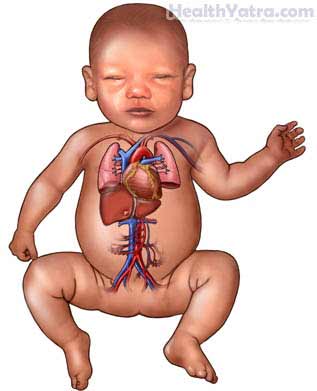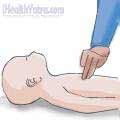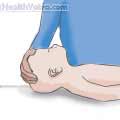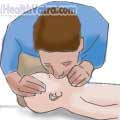Definition
Cardiopulmonary resuscitation (CPR) is a series of steps to help a person who is not responding and has stopped breathing. CPR helps deliver oxygen rich blood to the body tissue when the body is not able to do this on its own. Infant CPR should be used in babies less than 12 months of age.

Reasons for Procedure
CPR is given when an infant has stopped breathing. Reasons for this may include:
- Trauma
- Choking
- Drowning
- Electrical and lightning shocks
- Severe infection
- Severe allergic reaction
The outcome will depend on the cause and how soon effective CPR was started. Many victims are unable to regain a normal heartbeat after it has stopped.
Possible Complications
It is possible that ribs may fracture or break during chest compressions.
Greater risk is involved if CPR is delayed or not done correctly.
What to Do
Prior to Procedure
Check for responsiveness. Tap the infant and ask loudly “Are you okay?” Call the infant’s name if you know it. If the infant is unresponsive, follow these steps:
- If someone is with you, have them call for medical help right away and get the automatic external defibrillator (AED). An AED is a device that delivers electric shocks to the victim’s heart. If you are alone, do CPR for about two minutes before calling for medical help and the AED.
- Check to see if the infant is not breathing or only gasping. If this is the case, begin CPR by giving chest compressions:

-
- Place two fingers on the center of the chest just below the nipple line.
- Compress about 1-½ inches in most infants. Push hard and fast at a rate of at least 100 compressions per minute.
- Allow the chest to rise completely between compressions.
- Minimize interruption between compressions.
- Give 30 compressions.
- After 30 compressions, give two rescue breaths:

-
- Open the airway by gently tilting the head backward.

- Cover the infant’s nose and mouth with your mouth.
- Breathe two puffs of air into his mouth and nose. Breathe just until you see the chest rise. Breaths should be about one second each.
- If you are not trained in CPR, continue doing the chest compressions without giving rescue breaths.
- If medical help has not been called, call after five cycles of CPR (about two minutes). Call even if the infant is responding and is breathing on his own.
- Continue cycles of 30 compressions and two breaths until the AED is brought to you, medical personnel arrive, or the infant responds.
- If another person is present, take turns doing the chest compressions to avoid getting tired. If two people are giving CPR, the ratio of chest compressions to breaths is 15 compressions and two breaths.
- To use the AED:
- Turn the AED on.
- Attach the pads. Use the child-sized pads if available.
- Follow the prompts. If advised, deliver the shock. If the shock is not advised, the AED will tell you to resume CPR.
How Long Will It Take?
The length of time for CPR depends on the underlying causes and response time of medical help.
Will It Hurt the Infant?
The victim is unconscious when CPR is given. The procedure does not hurt. There may be some soreness in the chest after regaining consciousness.
Post-procedure Care
The emergency team will take over care when they arrive.
The victim will need to be taken to the hospital for evaluation following CPR.
Call For Help
If an infant is unresponsive and someone is with you, have them call for medical help right away. If you are alone, do CPR for about two minutes before calling for medical help.
